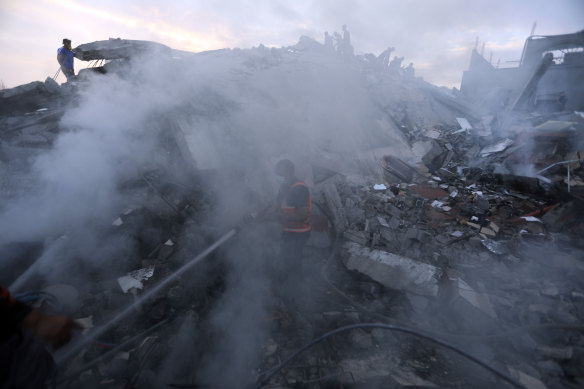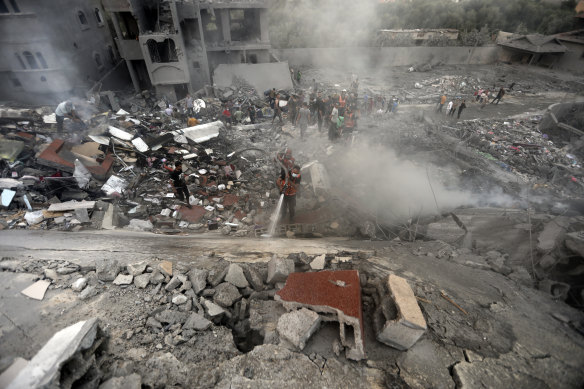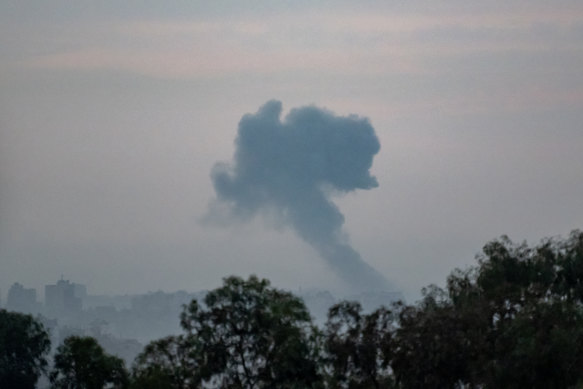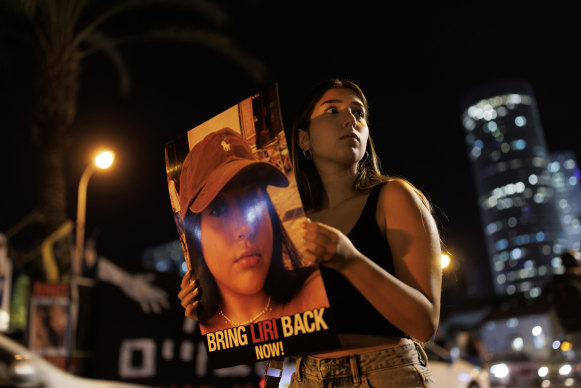This was published 1 year ago
Israel deploys missile boats to Red Sea as Gaza reports new internet blackout
By Najib Jobain, Jack Jeffrey and Lee Keath
Rafah, Gaza Strip: Israel has deployed missile boats in the Red Sea as reinforcements, the military said in a statement, following long-range missile and drone attacks claimed by Yemen’s Houthis.
Images disseminated by the military appeared to show Saar-class corvettes patrolling near Eilat port in the Red Sea, which Israel sees as a new front as its war in Gaza draws retaliation from Iran-aligned pro-Hamas forces elsewhere in the region.
The announcement came as Palestinians reported another widespread outage of internet and phone service in Gaza on Wednesday, hours after Israeli airstrikes levelled apartment buildings near Gaza City and as ground troops battled Hamas militants inside the besieged territory.
The Palestinian telecommunications company Paltel reported a “complete disruption” of internet and mobile phone services in Gaza, marking the second time in five days that residents were largely cut off from the world. Communications also went down over the weekend, as Israeli troops pushed into Gaza in larger numbers.
Humanitarian aid agencies have warned that such blackouts severely disrupt their work in an already dire situation in Gaza, where more than half of the population of 2.3 million Palestinians has been displaced and basic supplies are running low more than three weeks into the war triggered by Hamas’ bloody October 7 rampage into southern Israel.
Attempts to reach Gaza residents by phone were unsuccessful early on Wednesday. Internet-access advocacy group NetBlocks.org confirmed that Gaza “is in the midst of a total or near-total telecoms blackout consistent with” the weekend blackout.
Earlier, a barrage of airstrikes levelled apartment buildings in Jabaliya, Gaza’s largest refugee camp, near Gaza City. Rescuers frantically dug through the destruction to pull men, women and children from the rubble. The director of a nearby hospital where casualties were taken, Dr Atef al-Kahlot, said hundreds of people were wounded or killed, but the exact toll was not yet known.

Palestinians look for survivors under the rubble of a destroyed building following Israeli airstrikes in Nuseirat refugee camp.Credit: AP
Footage of the scene from Al Jazeera TV showed at least four large craters where buildings once stood, amid a large swath of rubble surrounded by partially collapsed structures. Dozens of rescue workers and bystanders dug through the wreckage, searching for survivors beneath the pancaked buildings. A group of young men pulled two children from the upper floors of a damaged apartment block, cradling them as they climbed down.
A Doctors Without Borders nurse described treating those hurt. “Young children arrived at the hospital with deep wounds and severe burns. They came without their families,” said Mohammed Hawajreh.
“Many were screaming and asking for their parents. I stayed with them until we could find a place, as the hospital was full with patients.”

Palestinians look for survivors under the rubble of a destroyed building following Israeli airstrikes in Nusseirat refugee camp, central Gaza Strip.Credit: AP
In a statement, Doctors Without Borders said it was “horrified” by the missile strikes.
Israel said the strike targeted senior Hamas military leader Ibrahim Biari, destroyed a militant command centre and an underground tunnel network, and killed dozens of other fighters. Military spokesman Jonathan Conricus said Biari was a key planner of the October 7 attack, and that the apartment buildings collapsed only because the underground Hamas complex had been destroyed.
Israel sent its forces into Gaza following weeks of air bombardments in retaliation for the attack by Iran-backed Hamas, and an Israel Defence Forces (IDF) statement said it carried out the wide-scale strike in Jabaliya on Hamas infrastructure “that had taken over civilian buildings”.
Dozens of Hamas combatants were in the same underground tunnel complex as Biari and were also killed when it collapsed in the attack, Conricus said.

An incoming Israeli military strike on buildings in Gaza City, as seen from the border area on October 31 in Sderot, Israel.Credit: Getty
“I understand that is also the reason why there are many reports of collateral damage and non-combatant casualties. We’re looking into those as well.
“His elimination was carried out as part of a wide-scale strike on terrorists and terror infrastructure belonging to the Central Jabaliya Battalion, which had taken control over civilian buildings in Gaza City,” the military said.
Hamas spokesperson Hazem Qassem denied any senior commander was in the camp, and called the claim an Israeli pretext for killing civilians. Palestinian health officials said at least 50 Palestinians were killed and 150 wounded.
A Hamas statement said there were 400 dead and injured in Jabaliya, which houses families of refugees from wars with Israel dating back to 1948.
Neither side’s accounts could be independently confirmed.
The Israeli military also said 11 soldiers were killed in fighting elsewhere in Gaza on Wednesday (AEDT), the biggest one-day loss for the armed forces since Hamas gunmen attacked southern Israel on October 7, killing about 300 soldiers and some 1100 civilians.
Israel’s Army Radio said most of the dead were infantrymen whose vehicle was struck by an anti-armour missile.
More than half the territory’s 2.3 million Palestinians have fled their homes, with hundreds of thousands sheltering in packed UN-run schools-turned-shelters or in hospitals alongside thousands of wounded patients. Israeli strikes have hit closer to several northern hospitals in recent days, alarming medics.
Thousands of people broke into its aid warehouses over the weekend to take food, as supplies of basic goods have dwindled because of the Israeli siege.
There has been no central electricity in Gaza for weeks, and Israel has barred the entry of fuel needed to power emergency generators for hospitals and homes.
UNRWA, which hundreds of thousands of people in Gaza rely on for basic services even in normal times, says 64 of its staff have been killed since the start of the war, including a man killed alongside his wife and eight children in a strike late on Monday.
“This is the highest number ever of UN aid workers killed in any conflict around the world in such a short time,” spokesperson Juliette Touma told the Associated Press. “UNRWA will never be the same without these colleagues.”
The war has also threatened to ignite fighting on other fronts.
Israel and Lebanon’s Hezbollah militant group have traded fire daily along the border, and Israel and the US have struck targets in Syria linked to Iran, which supports Hamas, Hezbollah and other armed groups in the region.
The military said it shot down what appeared to be a drone near the southernmost city of Eilat and intercepted a missile over the Red Sea on Tuesday, neither of which entered Israeli airspace.
Missiles from Yemen
Yemen’s Houthis waded into the Israel-Hamas war raging more than 1600 kilometres from their seat of power in Sanaa, declaring on Tuesday they had fired drones and missiles at Israel in attacks that highlight the regional risks of the conflict.
Part of an “Axis of Resistance” backed by Iran, the Houthis have rallied behind the Palestinians since Hamas attacked Israel on October 7, opening a new front for a movement that has waged war for eight years with a Saudi-led coalition in the Gulf.
Houthi military spokesperson Yahya Saree said in a televised statement the group had launched a “large number” of ballistic missiles and drones towards Israel, and there would be more such attacks to come “to help the Palestinians to victory”.
His statement confirmed the widening scope of a conflict that has unnerved states including the world’s biggest oil exporter Saudi Arabia, hardening fears of spillover as Israel seeks to destroy Hamas in its Gaza Strip stronghold.
Saree said it was the Houthis’ third attack on Israel since the start of the conflict, appearing to confirm they were behind a drone attack on October 28 that resulted in blasts in Egypt and was blamed by Israel on the Houthis, and an October 19 incident in which the US navy intercepted three cruise missiles.
Israeli National Security Adviser Tzachi Hanegbi said the Houthi attacks were intolerable, but declined to elaborate when asked how Israel might respond.
The Houthis’ slogan is “Death to America, death to Israel, curse the Jews and victory to Islam”.
The Iran-backed Houthi rebels in Yemen later issued a video statement claiming to have fired ballistic missiles and drones at Israel, saying it was the third such operation. They threatened to carry out more strikes “until the Israeli aggression stops”.
In the occupied West Bank, where Israeli-Palestinian violence has also surged, the army demolished the family home of Saleh al-Arouri, a senior Hamas official exiled over a decade ago. Ali Kaseeb, head of the local council in the village of Aroura, said the home had been vacant for 15 years.
The Hamas-run Health Ministry in Gaza said on Tuesday it registered the deaths of at least 219 people in the past day, bringing the death toll to 8525 since the war began.
Spokesperson Ashraf al-Qidra said in a televised news conference that the fatalities include 3542 children and 2187 women.
More than 1400 people have died on the Israeli side, mainly civilians killed during Hamas’ initial attack. Palestinian militants have continued firing rockets into Israel.
Zaki Abdel-Hay, a Palestinian living a few minutes’ walk from the road south of Gaza City, said people are afraid to use it. “People are very scared. The Israeli tanks are still close,” he said over the phone, adding that “constant artillery fire” could be heard near the road.

Friends and families of those taken hostage by Hamas gather to call for their return in Tel Aviv.Credit: Getty
Dawood Shehab, a spokesperson for Islamic Jihad, a smaller militant group allied with Hamas, told Al Jazeera television that its fighters were battling Israeli forces who were trying to cut off the main highway and a parallel coastal road farther west.
More hostages
Hamas has told mediators it will release a number of foreign captives in the coming days, Abu Ubaida, the spokesman of the group’s armed wing, al-Qassam Brigades, said in a video on its Telegram account on Tuesday.
The Brigades spokesman did not give more details on the number of captives or their nationalities.
He also said his group clashed with the Israeli army on three fronts and was able to “kill and injure a number of Israeli soldiers” as well as destroy 22 military vehicles.
The unit’s navy also used an underwater missile called “Aasif” for the first time in the conflict, Abu Ubaida said.
Reuters was not able to independently verify the claims.
Terror threat
The attack by Hamas on Israel will inspire the most significant terror threat to the United States since the rise of ISIS nearly a decade ago, FBI Director Christopher Wray said at a congressional hearing on Tuesday.

FBI Director Christopher Wray.Credit: Getty
Wray said that since the start of the Israeli-Palestinian conflict in Gaza earlier this month, multiple foreign terrorist organisations have called for attacks against Americans and the West, raising the threat posed by homegrown US violent extremists.
“The actions of Hamas and its allies will serve as an inspiration the likes of which we haven’t seen since ISIS launched its so-called caliphate several years ago,” Wray said.
The remarks came during a hearing before the US Senate homeland security and governmental affairs committee focused on threats to the United States. The US government has observed an increase in threats against Jews, Muslims and Arab Americans since fighting broke out in Gaza, officials have said.
AP, Reuters
More coverage of the Hamas-Israel conflict
- Cascading violence: Tremors from the Hamas attacks and Israel’s response have reached far beyond the border. But what would all-out war in the Middle East look like?
- The human cost: Hamas’ massacre in Israel has traumatised - and hardened - survivors. And in Gaza, neighbourhoods have become ghost cities.
- “Hamas metro”: Inside the labyrinthine network of underground tunnels, which the Palestinian militant group has commanded beneath war-ravaged Gaza for 16 years. The covert corridors have long provided essential channels for the movement of weapons and armed combatants.
- What is Hezbollah?: As fears of the conflict expanding beyond Israel and Hamas steadily rise, all eyes are on the militant group and political party that controls southern Lebanon and has been designated internationally as a terrorist group. How did it form and what does Iran have to do with it?